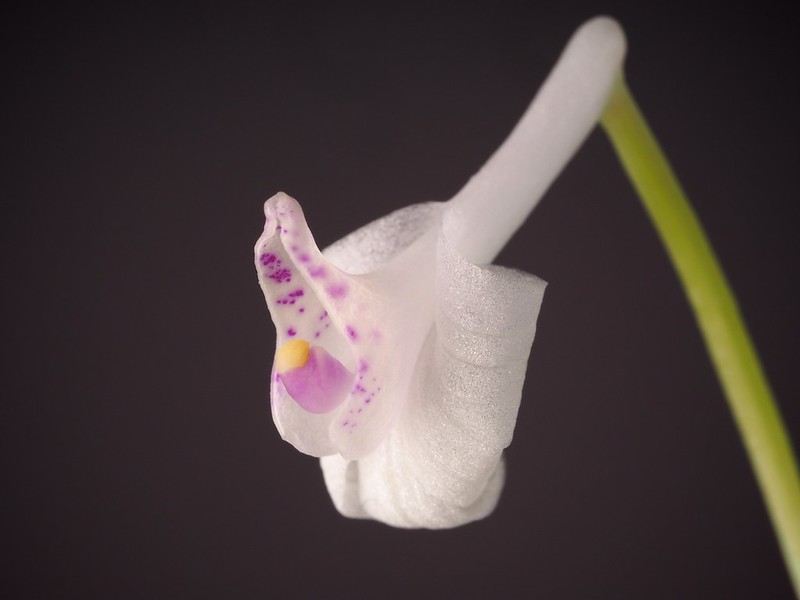 Anthogonium is a monotypic genus (meaning only 1 species is known in the genus). There are some studies of large scale molecular phylogeny of the Orchid family (e.g., Górniak et al. 2010, van den Berg et al. 2005), and this genus is one of the basal lineages within subfamily Epidendroideae. The subfamily Epidendroideae is the largest subfamily within Orchid family, which contains the majority of commonly grown orchids such as Cattleya, Cymbidium, Dendrobium, Phalaenopsis, Pleurothallids, and Vanda. But the relationship among the basal lineages of Epidendroideae are conflicting between the two studies, so it is difficult to say which other genus is most closely related to Anthogonium.
Anthogonium is a monotypic genus (meaning only 1 species is known in the genus). There are some studies of large scale molecular phylogeny of the Orchid family (e.g., Górniak et al. 2010, van den Berg et al. 2005), and this genus is one of the basal lineages within subfamily Epidendroideae. The subfamily Epidendroideae is the largest subfamily within Orchid family, which contains the majority of commonly grown orchids such as Cattleya, Cymbidium, Dendrobium, Phalaenopsis, Pleurothallids, and Vanda. But the relationship among the basal lineages of Epidendroideae are conflicting between the two studies, so it is difficult to say which other genus is most closely related to Anthogonium.Anthogonium gracile is a fairly widely distributed species; from North East India to Myanmar /Southern China/Vietnam region. A distribution map (occurrence data) and drawings can be found in Global Biodiversity Information Facility (GBIF). In that map, one occurrence in Yorkshire Dales National Park, UK is a herbarium sheet of cultivated plants from 1905, so it is not a natural occurrence as you would suspect.
I found a bit of habitat info in Tanaka's Orchids of Myanmar Vol. 2, which is a beautiful photo book of natural orchids (3 volumes in this series). It says that this species grows at the margion of other vegetation, and receives fair amount of light. It was observed in sandy soil. It grows along with Habernaria, Spathoglottis, and Arundina species. The color polymorphism exists within populations.
Color polymorphism: Rose-purple flower color is common in India, but white morphs were found in NE Indian state of Arunachal Pradesh (Rao 2006). This paper contains (blurry) photos of two color morphs. As a side note, this paper may be interesting for people interested in Paphiopedilum, since the main part of this paper describes variation of Indian Paphiopedilum. Additionally, in this web site, there are quotes about this species from The Orchids of the Sikkim-Himalayas by Sir. George King and Robert Pantling (1898). They talk about seeing the white color morphs, and some populations appear to be polymorphic (i.e., both color morphs coexist), which I thought interesting.
Medical use: This species is used as a folk medicine. Among Mao Naga people from North East India, the tuber is ground up and applied to the cracking heels for quick relief from the pain (Lokho 2012). In Darjeeling, India, the rhizome paste is used to treat bone fracture, dislocation, and boil (Bantawa & Rai 2009).
Culture: I got this plant in Fall 2014 from Andy's Orchids. When I received it, it had only 1 skinny flower shoot with no leaves. It did manage to flower last year around the same time, but only a couple flowers opened. In 2015 spring, it started to produce leaves fairly late, around May 1 (my record shows the shoot was 2cm in May 11, 2015), then it quickly made 2 long narrow leaves (about 40cm). Then it started to produce the flowering shoot around November. When the shoot was 10 cm or so, it dropped the leaves. I noticed that it was making a new long rhizomes, but I managed to break it when I was taking the photos...
I haven't found much information about its culture. It's in a small pot (2" square) and I don't know what media is used in there. In the summer, I water fairly frequently (every 2-3 days), and I think I was watering it once a week or every 4-5 days last winter. The growing temperature is relatively low (min/max of 65/75-80F in the summer and 55/68F in the winter). Moderate amount of light (slightly less than Cattleya), I believe. I still don't know how to grow this species, but it seems to be doing ok under this condition. I'll add more information as I learn more about the culture of this species and I would be excited to hear how you grow this species.
The flower in non-resupinate, so the lip is on top of the column.
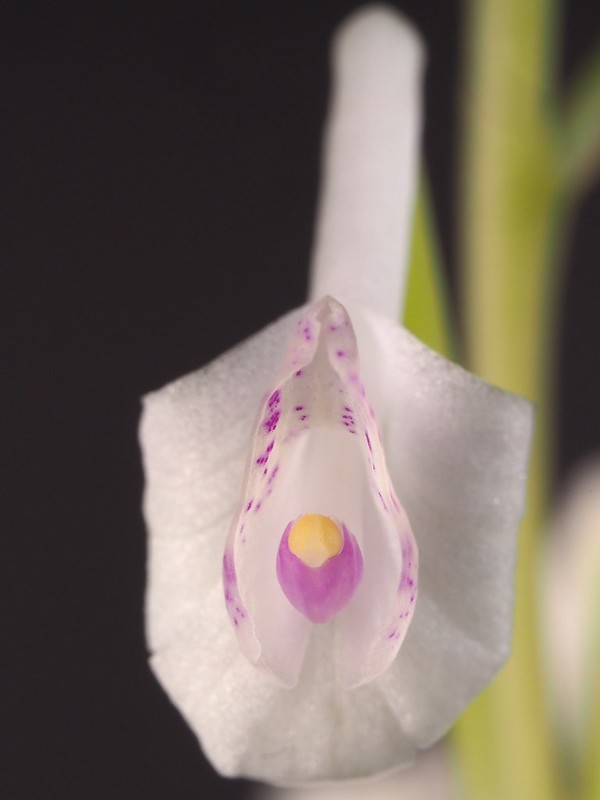
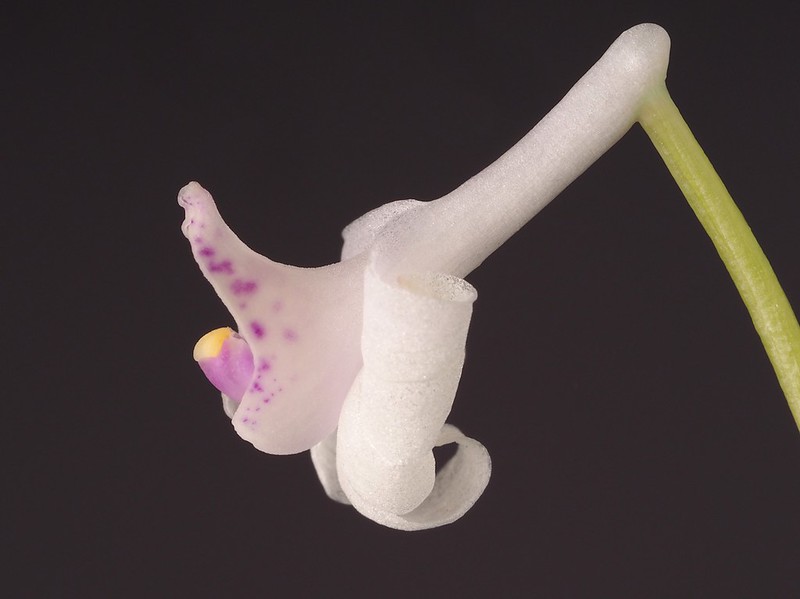
Older flowers become yellowish and drop.
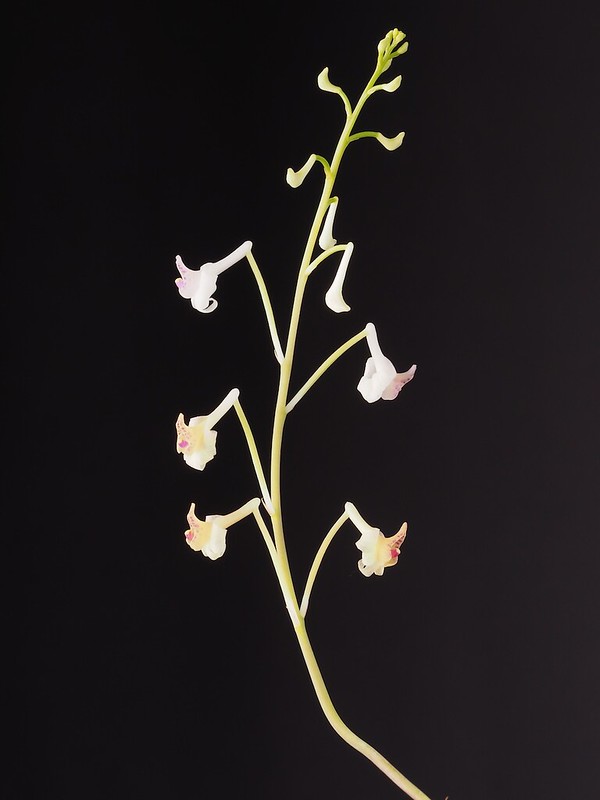
The flower shoot is pretty tall, around 50cm. I had to change the location to avoid the buds touching the light, so that's the reason why it is not growing straight.
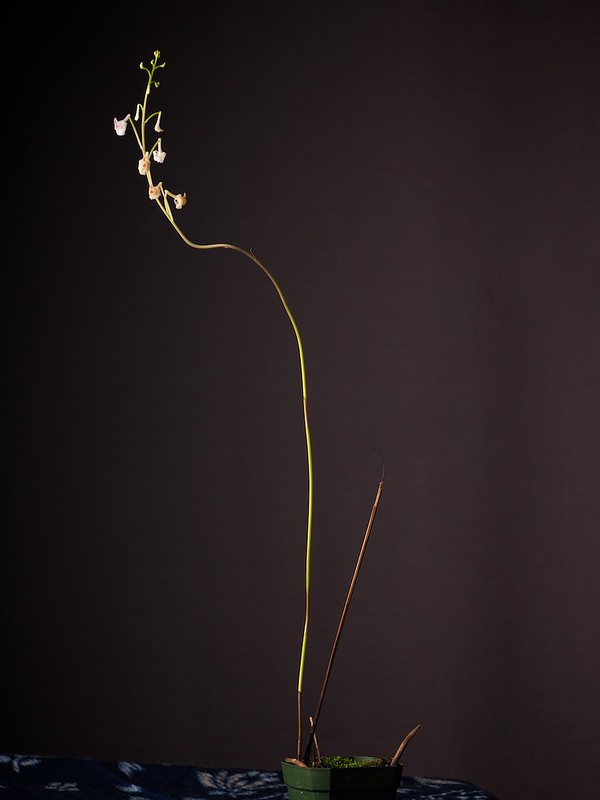
September 27, 2016 Update:
When I was taking the photos posted above in December 2015, I managed to break off a new shoot (stolon or rhizome?), which was 10 cm in length. You can see the place where the shoot was broken off at the right edge of the pot in the whole plant photo above. I just stuck it into a pot with some soil, and it looks like it managed to make new growth. The broken stick (shoot) became brown after a couple months, so I assumed that it died, but I left it like that until the repot time. Today I discovered this:
 |
| Left bottom was the tip of the shoot, top right was the base of the shoot, where it broke off. You can see two new growths on the right top side, which was under the soil. |
 |
| Magnified view of the new growths from the cutting. |
I was repotting, and there were 2 new growth points (the two pink/white colored broken pieces). I was being careful, but they broke off. I planted those separately, and I expect them to grow. Somehow, this species breaks easily... In the fall, it will soon start to initiate the inflorescence, and the leaves should die off. The flowers will open while the leaves are dropped in December-January. Then it will go dormant after 1-2 weeks of blooming. I keep them watered (a bit drier, like every 5 days). New leaves should appear after 5 months or so (around May) in my condition. The initial growth in the summer is rapid.
Literature cited:
Bantawa, P. and R. Rai, 2009. Studies on ethnomedicinal plants used by traditional practitioners, Jhankri, Bijuwa and Phedangma in Darjeeling Himalaya. Natural Product Radiance 8(5): 537-541. (PDF)
Górniak, M., O. Paun, M. W. Chase, 2010. Phylogenetic relationships within Orchidaceae based on a low-copy nuclear coding gene, Xdh: Congruence with organellar and nuclear ribosomal DNA results. Molecular Phylogenetics and Evolution 56: 784–795 (PDF)
Lokho, A. 2012. The folk medicinal plants of the Mao Naga in Manipur, North East India.
International Journal of Scientific and Research Publications 2(6): 1-8 (PDF)
Rao, A. N., 2006. Variability identification of Paphiopedilum, Anthogonium, and some Vandaceous species (Orchidaceae) genotypes - Their maintenance and propagation technology. Bulletin of Arunachal Forest Research 22 (1&2): 45-51 (PDF)
van den Berg, C., Goldman, D. H., Freudenstein, J. V., Pridgeon, A. M., Cameron, K. M., Chase, M. W., 2005. An overview of the phylogenetic relationships within Epidendroideae inferred from multiple DNA regions and recircumscription of Epidendreae and Arethuseae (Orchidaceae). American Journal of Botany 92: 613–624. (full text)
Rao, A. N., 2006. Variability identification of Paphiopedilum, Anthogonium, and some Vandaceous species (Orchidaceae) genotypes - Their maintenance and propagation technology. Bulletin of Arunachal Forest Research 22 (1&2): 45-51 (PDF)
van den Berg, C., Goldman, D. H., Freudenstein, J. V., Pridgeon, A. M., Cameron, K. M., Chase, M. W., 2005. An overview of the phylogenetic relationships within Epidendroideae inferred from multiple DNA regions and recircumscription of Epidendreae and Arethuseae (Orchidaceae). American Journal of Botany 92: 613–624. (full text)

Comments
Post a Comment